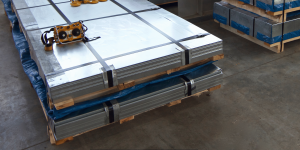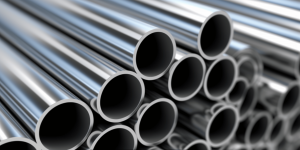Introduction
Galvanized steel and galvannealed steel are two types of coated steel sheets that are widely used in fabricating metal parts and products. The two products differ in that while galvanized steel is coated with zinc, galvannealed steel is first coated with zinc and then subjected to a heat treatment process, making it possible to adhere better to paints and other coatings.
Both these types of steel provide corrosion protection, and although they have some benefits and pitfalls in their use, they are instrumental. Identifying these two variations is crucial in defining which materials are most suitable for a given sheet metal fabrication.
Galvanized Steel
What is Galvanized Steel
Galvanized steel is steel treated with a layer of zinc to prevent rusting of the material’s surface. The zinc reacts with oxygen in the air and forms a layer of zinc oxide on the surface of the steel and shields the steel from moisture; hence, it does not rust.

By understanding this process, one can identify how Galvanized Steel is produced.
Steel becomes galvanized by passing through a hot-dip galvanizing process. The steel parts are then dipped in a pot containing molten zinc to coated with a thin layer of the metal. After the zinc has been heated and the steel is immersed, the zinc hardens and fuses with the steel.
Advantages of Galvanized Steel
– Excellent corrosion resistance. The zinc layer can also be applied to ferrous metals, and this enhances the life span of the material.
– Cost-effective. Compared to the other methods of corrosion protection, the initial costs of galvanizing are lower.
– Minimal surface treatment required. Galvanizing thus offers corrosion protection on steel that may not have received severe pre-treatment.
Disadvantages of Galvanized Steel
– Not paintable. The surface of the material is very smooth, and there is no way the paint can stick appropriately on it. Paint on a wall will deteriorate and end up flaking off at some point in the future.
– Poor welding properties. When welded, it turns into zinc vapor and, as a result, has poor weld strength. Certain parts may require welding before the galvanizing process.
– May be hard on tools. It is a common feature that the zinc layer forms a deposit on cutting tools applied in the process of machining.
Galvannealed Steel
What is Galvannealed Steel
It has a layer of zinc on top, just like galvanized steel, but it is done with a different method. However, it goes through an additional heating process where the zinc reacts with the steel to form an alloy. This produces a denser, less permeable film with better adhesion to the steel surface.

The process of producing Galvannealed Steel
The procedure begins in the same manner as hot-dip galvanizing. However, after the steel is removed from the zinc bath, it is exposed to an annealing furnace. The materials then diffuse and form zinc-iron alloy layers when the steel is heated to around 850°F. As this cools, the coating has a strong bond with the steel, which results in the formation of a very effective barrier.
Advantages of Galvannealed Steel
– Excellent paint ability. Since the surface is more uniform, a zinc finish enables paints and powder coatings to bond seamlessly.
– Good weldability. The plating of the zinc layer with another metal is a safer way to minimize the occurrence of zinc burn-off when welding.
– Unlike galvanized steel, it is not susceptible to wearing off quickly when rubbed against another surface.
Disadvantages of Galvannealed Steel
– Higher initial cost compared to using galvanized steel. Requires extra processing steps.
– Thinner gauge steels can be distorted during the heating process. May not be suitable for intricate metal components that need accurate and gentle handling.
– Not as sacrificial as galvanized steel. The alloy does not guard base steel as effectively once the coat has been damaged.
Which is Better for Sheet Metal Work?
For sheet metal fabrication projects, galvannealed steel often provides essential advantages over galvanized steel:
Paint Adhesion Benefits
The fact that it can be painted makes galvannealed steel right for sheet metal that needs matching color or aesthetic coating. This covers a range of interior and exterior architectural panels, building products, and automotive parts, which will be visible.
Limited Weld Distortion
Because galvannealed coatings do not vaporize and reduce the strength of welds like galvanized coatings, using galvannealed steel sheets makes it possible to weld fabricated parts with little likelihood of distortion or failure.
Where, the only issue is the protection from corrosion and it is hidden work such as the HVAC ductwork then, galvanized steel can be used. However, most fabrication requirements demand painting or welding properties that are more favorable with galvannealed steel.
Conclusion
Both galvanized and galvannealed steel offer corrosion protection through zinc coatings. However, since it can be painted and welded, galvannealed steel has an edge over other products in sheet metal fabrication where appearance and weldability are critical.
Although galvanized steel is used in more heavy-duty applications requiring less galvanizing, galvannealed steel is the most widely used steel for general sheet metal work. Also, increases in technology and development in the production procedure have gone on to narrow the price difference between the normal galvanized and the galvannealed steel.
